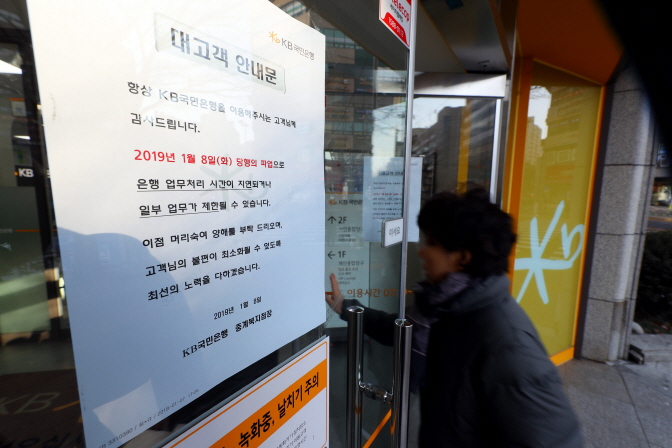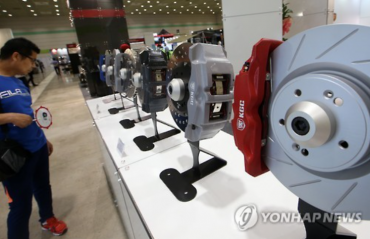
A notice is posted at a Seoul branch of KB Kookmin Bank on Jan. 8, 2019, informing customers of a union strike. (Yonhap)
SEOUL, Jan. 14 (Korea Bizwire) — A recent strike by employees of KB Kookmin Bank has raised controversy over idle manpower in the banking sector.
Usually, when there is a strike, all operations should stop for a while, creating inconvenience to customers.
However, most KB Kookmin Bank branches ran smoothly on the day of the strike without any inconvenience caused to users.
Ever since then, banks are being questioned about the need for actual brick-and-mortar branches and employees. The controversy is justified with the active use of non-face-to-face banking systems.
According to the financial sector on January 13, banks have been closing down branches in recent years.
In fact, statistics from the Financial Supervisory Service (FSS) confirm that the number of branches of the five major banks – KB Kookmin Bank, Shinhan Bank, Woori Bank, KEB Hana Bank, and NH Nonghyup Bank – has decreased by 8.2 percent.
None of these banks opened new branches in the past three years.
The main reason for the drop in branches is due to non-face-to-face banking systems. Users no longer have to go to the bank in person for banking.
As of last September, only 8.4 percent of all transactions were completed face-to-face. Most customers used Internet banking (52.6 percent) or an ATM (30.6 percent).
The emergence of Internet-only banks accelerated the decrease in the importance of bank branches.
Some even predict that there will be no problem even if the number of branches is reduced by half. Citibank is the example of such an extreme prediction.
In 2017, Citibank downsized from 134 branches to only 44 branches. Instead of releasing employees, the bank allocated its employees to other centers.
However, not every bank can follow the lead of Citibank, a foreign bank that is relatively free from the influence of financial authorities.
Nevertheless, with non-face-to-face banking systems increasing in popularity, the traditional role of the teller appears to be diminishing in importance.
Since the government pushes banks to hire tellers from specialized high schools, hiring tellers is inevitable.
However, the job description for tellers is expected to undergo some changes to meet changes in the banking system. Tellers of the future are expected to have a variety of different responsibilities involving IT and related fields.
There are others who think the aftermath of the KB Kookmin Bank strike is being wrongfully assessed. These people do not believe in idle manpower.
They believe in the need for bank branches and manpower. For them, the reason that that were no major problems during the strike was because it was short and pre-announced.
When using bank branches, it is not just about deposits and withdrawals. There are areas where transactions cannot be automated and have to be dealt with by a human being.
Also, those who are vulnerable to digital finance, including the elderly, may be left out of the financial sector if branches close down.
Amid the heated discussion over whether bank branches should close down, financial authorities are creating procedures for banks to follow when closing down branches.
The procedures will assess the branches in advance and come up with alternatives for bank users.
D. M. Park (dmpark@koreabizwire.com)






